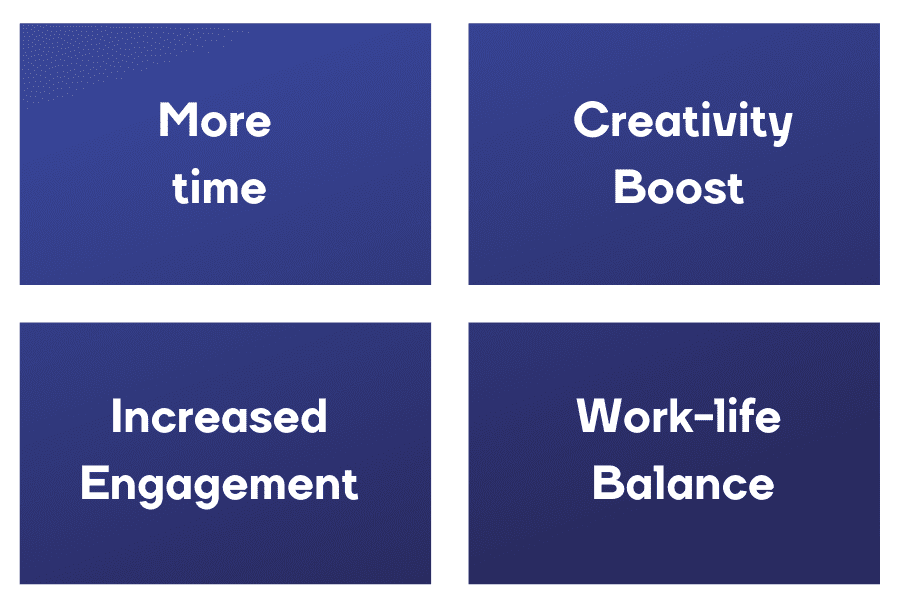Improving employee happiness with Intelligent Document Processing
- By Sietse Fierens
- | August 13, 2021
Reading, interpreting and categorizing every single incoming document and email is not a very satisfying task. What if you could skip this labor-intensive process? What if you could even skip the part of entering all data these documents contain in other systems and focus on more valuable tasks, like complex interpretation and decision making?
Keep on reading to discover how automating this whole cycle would improve your employees’ happiness.
Introduction
Did you notice how the previous paragraph said “Keep on reading to discover…”? It is ironic because that is exactly the opposite what we want you to do. If this would be a document full of data that you would need to extract yourself, you would be wasting your time. Luckily, it is just a blog post, so feel free to keep on reading.
Lots of people these days are still wasting time on manually handling every single incoming document. Data found in these documents is being entered into an ERP or CRM system by typing over emails or PDF attachments. In some cases, this process only contains a couple of documents per day. However, in most cases, especially in big enterprise companies, this process contains thousands of documents per day. Processing the latter is a mind-numbing and time-consuming task which should not be at the core of your day.
“Billions of USD are still being spent yearly on manual data entry, restructuring, and validation.”
Until recently, there were only classic templated based or keyword-matching solutions. These solutions use OCR and fixed rules to process (semi) structured docs. Unfortunately, more than 80% of all enterprise data worldwide is unstructured. Until now people had to process these complex documents manually.
Since the introduction of IDP, it is also possible to automatically process these semi- and unstructured documents.
This is where Artificial Intelligence comes in.
“Since 2013, the number of jobs that use AI has increased by 450%”
Memory.ai
Information and documents change all the time, so the software solution you are using should be able to learn and adapt with it. An Intelligent Document Processing solution does this by extracting the right information and making sense of a wide variety of documents on its own.
These evolutions have a huge potential of being very beneficial for organizations worldwide. However, they must come with clear goals and directions in order to take advantage of the full potential of automation.
How can IDP improve employee happiness?
Making sure employees are satisfied with their daily tasks is a crucial element for every organization. The most important step is to fix what makes them unhappy. Research shows that monotone work is one of the biggest reasons employees get tired of their job. Fixing what makes people unhappy sounds way more complicated than it is. The application of Intelligent Document Processing is actually a very straightforward first step in this process.
“Employees are focusing on high-value work thanks to automation in 39% of enterprises worldwide”
Automation as a Force for Good – 6 Steps to Transform Theory into Practice, IDC White Paper)
Being able to focus on more high-value tasks, results in people:
- Having more time
By automating time-consuming tasks, employees will have more time for more important tasks. Time spent on handling documents will reduce drastically, resulting in tasks being completed way faster. This will reduce the pressure on your employees’ shoulders.
- Being more creative
Feeling less stress and pressure about the piling number of unread mails and unhandled files, will give employees the opportunity to be more creative with their daily tasks. They will have time to brainstorm about new ideas, projects, etc.
- Being more engaged
Employee engagement and happiness go hand in hand. Happy people are more productive and vice versa. Those who are being swamped with monotone tasks are more likely to quit their roles and be less productive.
- Improving their work-life balance
It is not rocket science that apart from being more creative, people are happier when feeling less stressful. The general well-being and thus the work-life balance of your employees tends to increase lot when you implement innovative solutions to make their life easier.

What is your job when working with IDP?
Humans need AI but AI needs humans as well. Even after implementing the most accurate model, there will still be human actions needed in order to succeed as an organization, the following describes some examples:
- AI model management:
Automation based on AI is dependent on a combination of high-quality training data and performant AI models. Creating this training data and managing the AI model by performing human validation, retraining and testing is a skill that will become indispensable during the years to come. Metamaze is one of the only IDP platforms in the world that will allow you as a company to manage this whole cycle yourself from a business user interface. No coding skills needed. - Elaborate Data analysis:
Although artificial intelligence can extract more and more data from complex, unstructured sources, there is still a major role for humans in the analysis of that data. Extensive validation rules and matching/enrichment of data from documents with your back-end systems can all be done easily within Metamaze. However, when one wants to perform extensive analyzes based on certain expertise, the role of a subject matter expert (eg financial or operational) will always remain key.
- Complex Decision Making
A logical next step after analysis is decision making. The role of people in complex, important decisions is still significant. A good example of this is credit applications, a case with which Metamaze has a lot of experience.
A credit application involves many supporting documents and validation of the content, when done manually, is a very costly and time-consuming process. The latter can therefore be perfectly automated with Metamaze, so that a credit employee only has to focus on decision-making: granting the loan yes or no.
- Focus on customer interaction
A good customer experience is one of the most important drivers for many companies. When most of the time is spent on the classification, archiving and data extraction of your customer’s documents, however, there is often little time left to really engage with the customer. When intelligent document processing takes over all these tasks, your employees can once again provide the service a customer expects today.
In addition, there is the problem that with manual document processing the customer often has to wait days or weeks for feedback from a backlog administration, while Intelligent Document Processing can reduce this to a few minutes. Unless it is about incoming invoices, does not everyone want to process their incoming documents and provide feedback as quickly as possible?
Working together with AI
Artificial Intelligence is being implemented in all sorts of sectors all over the world. However, there is no reason at all to fear that machines, robots, or some sort of software will force companies to replace human employees. Companies that implement AI solutions to automate their processes only to cut jobs, might see a very short-term increase in productivity, but will collapse in the future.

As described above, AI and humans need each other. Research shows that the biggest performance improvements come when AI and humans work together, making use of each other’s capabilities and strengths. Human skills such as creativity, empathy, and collaboration work complementary with the ability of AI to process immense amounts of data and documents.
However, when your organization is going through this process of digital transformation, it is crucial to do this with clear principles. Whenever your organization is implementing an AI or IDP solution, make sure to take in account the following basic principles:
Based on (Automation as a Force for Good – 6 Steps to Transform Theory into Practice, IDC White Paper)
- People remain the core of your business.
Viewing people as an unnecessary cost that can be removed after implementing IDP will not result in long-term success.
- Create personal opportunities
Give your employees the opportunity to learn to work together with the solution. By doing so, you give them the opportunity to develop their skills even further.
- It’s about more than reducing costs
You can improve more than just cost reduction. Transparency, engagement, and happiness can be increased while employee churn rate and repetitive work can be decreased. - Reinvest resources wisely
Resources returned (time, money, workforces) by automating your document processing, can be used to reach your organization’s goals faster. By doing so, this can create a better atmosphere within the company which increases engagement and happiness. - Be transparent
Sharing successes and challenges will amplify the true value of automation.
Conclusion
Companies that do not use AI are at risk of becoming obsolete. Using AI to automate your document processing is a great first step in the right direction. Automating this tedious flow will decrease the amount of monotone work that has to be done by humans.
Do not be fooled, you still need your people to use their more valuable strengths that a machine or software does not have. This is the way to go in order to increase productivity, but most importantly, the happiness of the people within your team.
CONTACT US
Book a demo today
Curious how Metamaze works and what it can mean for your enterprise?
